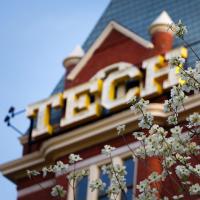Many years from now, when five current undergraduate students revisit Georgia Tech as alumni, they can point to a building on campus and say, “I helped make that building more environmentally friendly.”
…The fast-growing Internet of Things (IoT) consists of millions of sensing devices in buildings, vehicles and elsewhere that deliver reams of data online. Yet this far-flung phenomenon involves so many different kinds…
An international team of scientists has developed a relatively simple mathematical explanation for the rogue ocean waves that can develop seemingly out of nowhere to sink ships and overwhelm oil platforms with walls…
A tiny mirror could make a huge difference for scientists trying to understand what’s happening in the micron-scale structures of living cells.
By growing cells on the mirrors and imaging them using super-…
An industry-driven consortium has developed a national roadmap designed to chart the path to large-scale manufacturing of cell-based therapeutics for use in a broad range of illnesses including cancer, neuro-…
For plants and animals fleeing rising temperatures, varying precipitation patterns and other effects of climate change, the eastern United States will need improved “climate connectivity” for these species to have a…
A high-resolution model of how soil erosion impacts the carbon cycle of a small South Carolina watershed may help explain an apparent imbalance in the world’s carbon budget. Explaining that apparent imbalance is…
In September of 2015, Georgia Tech became a founding member of the MetroLab Network, with GT’s Center for Urban Innovation as administrative lead. The MetroLab Network is a group of 34 cities, 3 …
A 3D printer based on technology developed at Georgia Tech was recently lauded by international industrial technology leaders for the device’s faster and less costly method of making ceramic cores and molds used in…
By increasing the level of a specific microRNA (miRNA) molecule, researchers have for the first time restored chemotherapy sensitivity in vitro to a line of human pancreatic cancer cells that had developed resistance…
A pinch of poison can be good for a body, at least if it’s heme.
In minuscule amounts, it works in cells as an essential catalyst called a cofactor and as a signaling molecule to trigger other processes. Now,…
You’ve injured your knee. A doctor straps a listening device to it, and the noises you hear coming out of it are cringe-worthy. “Crackle! Krglkrglkrgl! Snap!”
Your knee isn’t breaking; it’s only bending, and in…
This may sound like a familiar kind of riddle: How many brilliant mathematicians does it take to come up with and prove the Kelmans-Seymour Conjecture?
But the answer is no joke, because arriving at it took…
A Georgia Institute of Technology research team has devised a novel way to help keep a driverless vehicle under control as it maneuvers at the edge of its handling limits. The approach could help make self-driving…
Energy sustainability and climate change are two of the greatest challenges facing humankind. Unraveling these complex and interconnected issues demands careful and objective assessment. Fact and Fiction in Global…
Cities are the largest technological artifacts that we build. We can see them from space. At the opposite end of the spectrum, we call the things that we build which can’t be seen with the naked eye “…
By detecting semantic inconsistencies in content, researchers have developed a new technique for identifying promotional infections of websites operated by government and educational organizations. Such attacks use…
Check out the latest newsletter from the Brook Byers Institute for Sustainable Systems at Georgia Tech.
As climatologists closely monitor the impact of human activity on the world’s oceans, researchers at the Georgia Institute of Technology have found yet another worrying trend impacting the health of the Pacific Ocean…
A nanoparticle commonly used in food, cosmetics, sunscreen and other products can have subtle effects on the activity of genes expressing enzymes that address oxidative stress inside two types of cells. While the…























